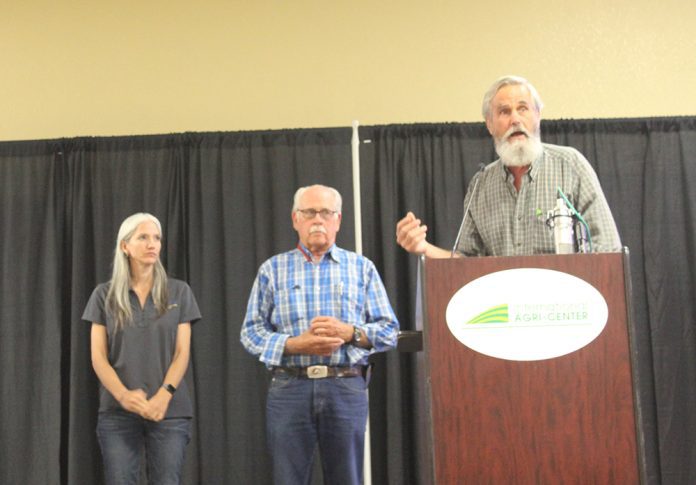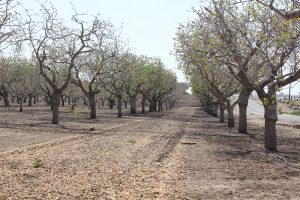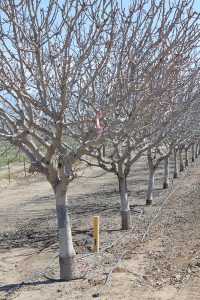
Drought and salinity challenges in pistachio production as well as advances in estimating crop nutrient and water use were highlighted in a UC-hosted Advances in Pistachio Water Management workshop.
Before getting down to the nuts and bolts of irrigation management, Mike Wade from the California Farm Water Coalition presented a look at water supply shortages and implications for nut production in the San Joaquin Valley, home to 96% of California’s pistachio production.
Wade pointed out that estimates for 2022 show a net water shortage of 3.6 million acre-feet. One bright note, he said, was a recent Public Policy Institute of California report that noted in wet years, water supplies exceed environmental demand, justifying proposed water storage projects.
“Environmental regulations have chipped away at the ability to divert water. The PPIC report is key to restoring agricultural water,” Wade said.
Soil-Plant Water Relations
UCCE Farm Advisor Mae Culumber from Fresno County provided a look at soil-plant water relations for pistachio trees under non-stress and stress conditions.
Pistachio trees, Culumber said, have some drought adaptations. They can exploit deep reservoirs of water with extensive root systems. Their leaves have a thick cuticle adapted to maintain turgor in arid conditions. During drought, pistachio leaves form a higher density of smaller stomata that reduce water loss and increase water use efficiency. Pistachio trees can also compartmentalize toxic ions and produce anthocyanins and carotenoids to maintain cell osmotic pressure. The trees can also maintain photosynthesis and carbon assimilation at very low water potentials and high salinity levels.
The stomata, Culumber explained, regulates carbon dioxide absorption for photosynthesis and regulate water transpiration. Extreme dehydration closes stomates, resulting in lower transpiration, photosynthesis and gas exchange. Potassium, she added, is essential for regulating stomatal conductance and maintaining turgor.
Severely limited water supply to pistachio trees reduces transpiration, dehydrates trees and impacts important physiological processes. This results in slow vegetative growth, oxidative stress and leaf necrosis, reduced photosynthesis and carbohydrate assimilation. There is intensified bud abscission and reduced floral bud viability. Lower yields, increased early splits and increased non-split shells and blanks are also results of severe water stress.
Water demand does fluctuate through the season and also varies with tree age, vigor, crop load, climate, soil texture and salinity levels.
High salts in the soil have a similar impact as drought stress. Increased salt levels reduce water potential between the soil and tree, which must make physiological adjustments to maintain the osmotic gradient for water movement from root to transpiring tissues. Those adjustments, Culumber noted, have a high energy cost and lead to reduced tree vigor.
Although pistachio trees are known for their ability to be productive in high-salinity conditions, irrigation water exceeding 5-6 dS/m EC is not viable for long-term production, especially if the saline or sodic conditions are coupled with poor soil drainage.
Culumber said high salt levels in the soil will interfere with absorption of potassium and calcium and other essential nutrients.

Meeting Nutrient Needs a Challenge
Irrigation water limitations also pose challenges to meeting nutritional needs of tress. Doug Amaral, UCCE pomology and soil-water advisor in Tulare and Kings counties, focused on the challenges of meeting nitrogen and potassium needs and minimizing stress.
Nutrients do not move easily in dry soil to reach roots and there is low organic matter decomposition in dry conditions. There is a lack of transpiration to uptake nutrients and low nutrient availability. The result is more available N in the soil and less available K.
Leaf analysis alone will not present a full picture of the nutritional status of trees, Amaral said. Soil and water analyses are needed. To optimize the use of fertilizer, fertilizers must be present in the root zone when they are most likely to be used by the tree. The uniformity of the irrigation system will define uniformity of the fertilizer application, Amaral said.
Agronomic practices that can help improve soil water and nutrient use efficiency include reducing tillage and increasing residue, which will reduce evaporation loss and soil temperature and increase water infiltration and storage.

Evapotranspiration Affected by Salt
UCCE Agriculture Water Management Specialist Daniele Zaccaria provided insight on results of a recent study on pistachio ET and Kc. Growers have limited information on ET and Kc for pistachios grown under microsprinkler systems in salt-affected soils, he said, and further pistachio expansion into those marginal soils is expected.
The UC team conducted the study to measure ET and Kc of well-watered pistachio trees on non-saline and increasingly saline soils to provide updated information and determine the effects of soil salinity on canopy growth.
Zaccaria said the study showed that salinity affects ET by different mechanisms. It decreases the soil osmotic potential, resulting in more metabolic energy needed to extract water and nutrients. Salinity also reduces plant growth, resulting in less light interception, reducing leaf efficiency and assimilation of water and nutrients. Small canopies allow more sunlight to reach the soil surface in the orchard, causing more soil evaporation if the soil is wet.
Other Water-Related Implications
Other water-related implications for pistachio production include tree training to improve water use efficiency. Bruce Lampinen at UC Davis said the objective is to bring pistachio trees into production more rapidly at lower costs with higher water use efficiency while establishing a strong tree structure.
The study used three treatments: conventional following the Pistachio Production manual, a modified central leader and an unheaded/unpruned tree.
At all the trial sites, Lampinen said that the modified central leader and unpruned trees had larger rootstocks, stronger branch connections, were taller and had more early fruiting positions, indications of earlier yield potential and higher water use efficiency.
Blake Sanden, retired Kern County UCCE water, soils and agronomy advisor, listed tools growers can use to accomplish ‘real field’ irrigation scheduling. His list included a starting estimate of crop water demand, field soil/salinity variability and water holding capacity. Field characteristics, record keeping and real-time water status feedback accomplished with hand probes, sensors or aerial imagery were also on the list.
“Pistachio growers have to integrate all the factors to make irrigation work,” Sanden said.


Cecilia Parsons | Associate Editor
Cecilia Parsons has lived in the Central Valley community of Ducor since 1976, covering agriculture for numerous agricultural publications over the years. She has found and nurtured many wonderful and helpful contacts in the ag community, including the UCCE advisors, allowing for news coverage that focuses on the basics of food production.
She is always on the search for new ag topics that can help growers and processors in the San Joaquin Valley improve their bottom line.
In her free time, Cecilia rides her horse, Holly in ranch versatility shows and raises registered Shetland sheep which she exhibits at county and state fairs during the summer.















